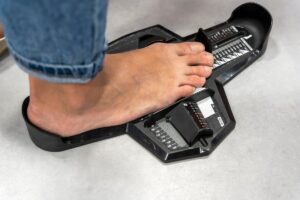Many individuals encounter daily challenges related to having wide feet, but finding the ideal footwear can be an enjoyable and rewarding experience. Common concerns such as discomfort, blisters, and a limited variety of shoe options often arise. However, understanding the unique needs of your feet can greatly enhance your shopping experience. Wearing improperly fitting shoes can lead to serious foot health issues, including bunions and chronic pain. Acknowledging that wide feet are a normal variation is the first step toward comfort, and selecting the right shoes can prevent long-term foot health problems. This guide aims to deepen your understanding of wide feet and help you discover shoes that combine comfort and style seamlessly.
Understand the Unique Characteristics of Wide Feet
Gaining a comprehensive understanding of your wide feet is crucial for making informed choices when it comes to footwear. Research suggests that nearly 30% of adults have feet that exceed standard shoe sizes. Factors such as genetics, age, and lifestyle habits influence foot width significantly. By recognizing these elements, you empower yourself to choose shoes that are tailored to your distinct foot shape and enhance your overall comfort.
Appreciating the Natural Variations in Foot Structure
Foot width varies naturally among individuals, much like height and body shape. Your genetic makeup plays a substantial role in determining your foot structure. If wide feet run in your family, take comfort in knowing that this is a common genetic trait rather than a medical concern. Understanding these genetic influences allows you to embrace your unique foot characteristics and make more informed choices regarding your footwear.
Identifying Changes in Foot Width Over Time
Throughout life, various changes can lead to the development of wider feet. For instance, pregnancy can increase foot width by as much as one full size, and aging or weight fluctuations can also impact your foot size. Additionally, prolonged periods of standing or certain medical conditions may contribute to foot widening over time.
Being mindful of these changes equips you to adjust your footwear selections accordingly. Regularly measuring your feet is recommended, as they can change size every few years. Factors such as weight changes, aging, and physical activity all play a role in these variations. Neglecting to adapt your shoe choices to these changes can lead to foot issues, including bunions, corns, and ongoing discomfort.
Investigate the Common Causes of Wide Feet
Understanding the underlying reasons for your wider-than-average feet is essential for finding effective solutions. Various factors contribute to wide feet, including genetics, medical conditions, and lifestyle choices. By identifying these factors, you can tailor your search for footwear that meets your specific needs.
Exploring Genetic Influences on Foot Width
Your family history and inherited foot structure are pivotal in determining your foot width from birth. Traits such as bone structure and arch type are passed down through generations, impacting the development of your feet. By understanding these hereditary aspects, you can gain valuable insights into the unique shape and characteristics of your feet.
Recognizing Medical Conditions That Influence Foot Width
Sometimes, underlying health issues can lead to wider feet. Common conditions such as diabetes, arthritis, and edema can alter the shape and dimensions of your feet.
The impact of medical conditions on foot width can be temporary or permanent. For example, your feet might swell during pregnancy, after an injury, or due to circulation issues. Regular check-ups with your healthcare provider can help you monitor any changes in your foot health and address potential problems proactively.
Understanding Lifestyle Factors That Affect Foot Width
Experts agree that your daily habits significantly affect your foot width. Extended periods of standing, excess weight, and poor footwear choices can contribute to gradual widening of your feet over time.
Your lifestyle, combined with genetic and environmental factors, determines your foot width. High-impact activities and inadequate shoe choices can accelerate this change. The nature of your job and daily routines plays a critical role in your foot health and overall foot shape.

Acknowledge the Health Implications of Wide Feet
When compared to standard foot sizes, wide feet can lead to serious health complications if not properly accommodated. The width of your feet influences your entire body’s alignment and can affect your joints, posture, and overall mobility. Studies indicate that a staggering 72% of people do not wear shoes that fit correctly, which can lead to preventable foot ailments.
Comprehending the Physical Effects of Wide Feet
Approximately 65% of individuals with untreated wide feet suffer from chronic foot pain. Inadequate support for your feet can force your body to adjust its walking pattern, potentially leading to knee pain, hip discomfort, and lower back issues. Over time, these compensatory changes can result in lasting joint problems if you continue to wear shoes that don’t fit properly.
Addressing Daily Discomfort Challenges
When your footwear fails to accommodate your wide feet, everyday activities can become overwhelming. You may experience immediate discomfort, blisters, and pressure points that restrict your ability to move freely. Research shows that 80% of individuals with wide feet report decreased activity levels due to foot discomfort.
The repercussions of wearing ill-fitting shoes extend beyond temporary discomfort. Your feet may develop painful conditions such as bunions, corns, and calluses, which can adversely affect your balance and stability, making you more susceptible to falls and injuries. Choosing the right footwear is essential for maintaining your foot health and overall well-being.
Find Effective Footwear Solutions for Wide Feet
Locating appropriate footwear is vital for individuals with wide feet, ensuring both comfort and foot health. Your shoes should provide ample room while delivering the necessary support and stability for your daily activities.
The Importance of Accurate Measurement for Shoe Fitting
Taking accurate measurements of your feet is essential to selecting shoes that fit correctly. Measure your feet at the end of the day when they are at their largest, and be sure to measure both feet, as sizes can differ between the two.
Identifying the Best Shoe Types for Wider Feet
To effectively accommodate wide feet, certain shoe styles are more appropriate than others.
| Feature | Benefit |
|---|---|
| Wide toe box | Allows natural toe spread |
| Adjustable closures | Customizable fit |
| Breathable materials | Reduces swelling |
| Deep heel cup | Provides stability |
| Flexible sole | Adapts to foot shape |
- Athletic shoes featuring breathable mesh uppers
- Sandals equipped with adjustable straps
- Loafers that come in wide widths
- Boots designed with stretch panels for added comfort
For instance, specific shoe designs can greatly enhance your comfort levels.
| Shoe Type | Best Features |
|---|---|
| Running shoes | Extra width options available |
| Walking shoes | Roomy toe area for comfort |
| Casual shoes | Made from stretchable materials |
| Dress shoes | Available in multiple width options |
| Work boots | Designed specifically for wide-fit needs |
Essential Guidelines for Shopping for Wide Feet
Your success in finding comfortable shoes for wide feet depends on thoughtful planning and informed choices. Seek out specialty retailers that offer wide-width options and have knowledgeable staff who can assist you with accurate measurements. It’s advisable to shop during the afternoon when your feet are naturally at their widest for the best fit.
Selecting the Right Brands for Wide Feet
To find suitable footwear, prioritize brands recognized for their wide-width offerings, such as New Balance, Brooks, and ASICS. These brands create shoes with extra room in the toe box and midfoot area, enhancing comfort for those with wide feet. Emphasizing quality construction and proper support is crucial for ensuring long-term satisfaction and comfort.

Expert Fitting Tips for Maximum Comfort
Successful shoe purchases hinge on effective fitting practices. Adhere to these essential guidelines:
- Measure both feet while standing for accuracy
- Ensure thumb-width space in the toe area for comfort
- Try on shoes with your regular socks for the best fit
- Walk around in the shoes to assess comfort and fit
- Shop during the late afternoon when your feet are at their largest
Feeling immediate comfort is essential for making the right choice.
Fitting procedures require attention to detail and patience. Consider these additional factors:
- Check for adequate arch support to prevent discomfort
- Ensure no pressure points are present that could cause pain
- Verify heel stability to support proper alignment
- Test flexibility at the ball of the foot for ease of movement
- Explore various lacing techniques for a customizable fit
Noticing these details will aid you in finding the perfect fit for your wide feet.
Proper Maintenance and Care for Your Footwear
To maintain good foot health and prolong the life of your shoes, regular care for your wide feet is essential. Incorporate thorough cleaning and proper drying of both shoes and feet into your daily routine to prevent issues like fungal infections and unpleasant odors. Consistent maintenance can reduce foot pain by up to 40% and extend the lifespan of your footwear significantly.
Daily Practices to Boost Foot Health
Effective practices for your wide feet include rotating between different pairs of shoes to allow adequate drying time and minimize excessive wear. After each use, wipe your shoes clean and consider using shoe trees to help maintain their shape. These simple actions can increase the lifespan of your shoes by up to 2 years and provide enhanced support for your feet.
Long-Term Strategies for Foot Health Prevention
Consistent care for your wide feet involves diligence to prevent future complications. You should replace your shoes after 400-500 miles of walking or whenever you notice visible signs of wear. Regular foot measurements are also necessary, as your foot width can change over time.
While caring for your footwear, prioritize foot exercises and stretches. Engaging in regular foot exercises can enhance flexibility by 30% and alleviate discomfort. Ensure your feet receive proper circulation by avoiding prolonged periods of inactivity, and consider using compression socks if you need to stand for extended durations.
Reflecting on your journey to find the perfect footwear for wide feet can be simple with the right knowledge. By understanding your foot width, selecting brands that cater to wider sizes, and utilizing effective measurement techniques, you can make better shoe choices. Your comfort is of utmost importance, so take the time to try on various shoes and ensure they offer ample space for your feet. By following these recommendations and being mindful of how your shoes fit, you will discover footwear that supports your daily activities while keeping your feet healthy and pain-free.
Your Questions Answered: FAQs About Wide Feet
What’s the most effective method to measure my feet for suitable wide-width shoes?
Stand on a piece of paper while wearing your usual socks. Trace both feet and measure their length and width at the widest points. It’s best to do this in the evening when your feet are at their largest. Compare these measurements against standard shoe size charts and select shoes that correspond to the measurements of your larger foot. Always walk around in new shoes for several minutes to evaluate comfort before making a decision.
Which shoe features should individuals with wide feet prioritize for the best fit?
Look for shoes that offer a wide toe box, allowing your toes ample room to spread naturally. Seek shoes labeled with “W” for wide or “EE” width designations. Materials such as soft leather or mesh that stretch and adapt to your foot shape are ideal. Choose footwear with adjustable features like laces or straps, and steer clear of pointed toe designs in favor of rounded or square toe shapes.
How can I prevent foot problems caused by incorrect shoe sizes?
Replace any shoes that show signs of significant wear and tear. Purchase from brands that specialize in wide-width options. Ensure that your toes have sufficient space to move comfortably. If necessary, consider using shoe inserts for additional support, and alternate between different pairs of shoes daily. Regularly check your foot size, as it can change over time, and discontinue wearing any shoes that cause pain or discomfort.
The Article The Ultimate Wide Feet Guide: Concerns, Footwear Tips, and More appeared first on My Shoes Finder
The Article Wide Feet Guide: Essential Tips and Footwear Solutions Was Found On https://limitsofstrategy.com



This is such an important discussion! I’ve struggled with finding comfortable shoes for years, and I’ve learned that embracing the unique characteristics of my wide feet has been key to my journey. It’s amazing how much of a difference proper footwear can make—not just in comfort, but in overall well-being.
It’s refreshing to hear about your journey with finding comfortable shoes, especially embracing the unique characteristics of wide feet. It’s a struggle many can relate to, yet not everyone talks about. The importance of footwear goes beyond just aesthetics; it plays a critical role in our day-to-day comfort and overall health. When shoes don’t fit well, it can lead to all sorts of issues, from blisters and calluses to more serious problems like joint pain or even misalignment over time.
It’s great to hear you’ve found a way to embrace the unique characteristics of your wide feet. It really can be a journey figuring out what works, can’t it? I think a lot of people underestimate how much comfort and the right footwear can impact not just your day-to-day life, but your overall well-being. When your feet hurt, it can throw everything else off—your mood, your energy levels, even how you interact with your surroundings.
I really appreciate this post because as someone with wide feet, I’ve faced countless struggles in finding the right shoes. It’s interesting how little emphasis is placed on foot width in the mainstream footwear market; it seems like many brands don’t fully acknowledge that a significant number of people don’t fit into their so-called ‘standard’ sizing. I often find myself compromising on style for comfort because I don’t want to end up with blisters or worse yet, some painful foot condition.
Ah, wide feet – the uninvited guests to the shoe party! Truly, the ultimate nemesis of stylish footwear. As someone whose feet clearly missed the memo about “standard sizes,” I completely relate to the daily challenges you mentioned. There’s a special kind of sorrow that accompanies the sight of beautiful shoes left forlornly on the shelf because their narrow little embrace could never accommodate my flippers.
It’s a tough reality we face with wide feet, isn’t it? It’s like we’re constantly haunted by the allure of those gorgeous shoes, all while knowing they’ll never be a proper fit. It’s frustrating how the fashion industry often forgets about those of us who don’t fit into that narrow mold.